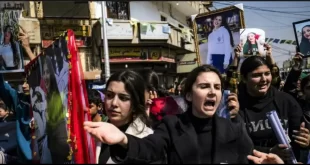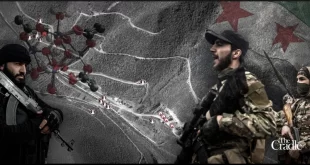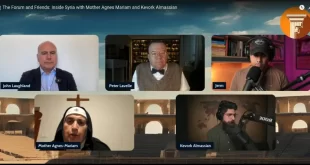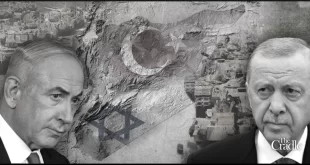from the NewsDesk at The Cradle, February 3, 2023
In March 2019, former US President Donald Trump startled Washington’s war establishment by announcing that the mission of “eliminating terrorism” had been accomplished in Syria.
Seven months later, Trump solidified his claims by celebrating the assassination of ISIS leader Abu Bakr al-Baghdadi by a US special forces operation in rural Idlib, in the north of the country.
In reality, the US president had been angling to exit Syria for some time, and the absence of terrorism provided that excuse. Trump had promised his voter base to wind down expensive foreign military adventurism, and viewed the high cost of military deployment in Syria as disproportionate to the gains realized.
But while withdrawing US forces from various locations in Syria’s north and northeast, the American president was pressured to maintain a small number of troops in the oil-rich countryside of Hasakah and Deir Ezzor, and in the Al-Tanf base, an area crucial to Israel’s strategic interests as it is located on the border with of Iraq and Jordan, and on the hypothetical road that connects Tehran to Beirut.
Trump, known for his brazen proclamations, publicly stated that “oil interests” were the reason for keeping this small contingent of US troops in the embattled Levantine state. The wholesale exit of US forces would have paved the way for Syrian and Russian troops to take back control of the northeast, and for Moscow to move forward with its peace plan through the Astana Process with Iran and Turkiye.
The facade of ‘fighting terror’
With the arrival of Democratic President Joe Biden to the White House, Washington shifted its priorities and sought to maintain a protracted presence in Syria under the pretext of “fighting terrorism.” ISIS cells were magically reactivated in the Syrian desert, a development heavily circulated in US media through “intelligence sources.” This prompted accusations from Moscow that Washington is supporting terrorism from its Al-Tanf base, which Russian planes bombed last July.
Amidst escalating hostilities between the US and Russia over Ukraine, Syrian field sources have informed The Cradle of the existence of communication channels between the Al-Tanf base and ISIS cells that carry out scattered attacks in the Syrian Desert against the Syrian Arab Army (SAA) and its allied, Iran-backed factions.
The sources have also noted a marked shift in both ISIS tactics and the terror group’s access to advanced weapons and modern communication equipment that have been discovered in their hideouts. Given Iraq’s stringent measures on all border crossing with Syria – digging a trench along the border, building a separation fence, and installing surveillance cameras and checkpoints – it is unlikely that ISIS could obtain these resources without support from a powerful nation.
Kurdish forces employ the ISIS threat
During every Turkish threat to attack US-backed Kurdish forces in the country’s northern provinces, the Syrian Democratic Forces (SDF) raises the specter of ISIS and its expansion, which is used to justify the continued Kurdish occupation of northern Syria to repel these attacks.
This pattern repeated itself during the 2016-2017 Turkish Euphrates Shield operation against ISIS and Kurdish targets, the 2018 Olive Branch operation when Turkish forces invaded Afrin in Aleppo’s countryside, and the 2019 Turkish offensive called the Peace Spring operation.
The trend continued last December, when Ankara threatened to attack Kurdish-held territories in Syria’s north. The SDF, which had halted operations against ISIS, quickly reversed its decision two days later.
In addition to playing the ISIS card to justify its relevance, the SDF – which is affiliated with the Kurdish Democratic Union Party (PYD) which Ankara considers an extension of the terrorist-designated Kurdistan Worker’s Party (PKK) – has another lever it frequently employs.
The Kurdish group controls dozens of prisons that house thousands of ISIS leaders, fighters, and their families, the most notorious of which are Al-Hol camp near the Iraqi border, and Al-Sinaa prison in the Hasakah Governorate.
And the SDF, in coordination with US strategists, have employed this leverage to release ISIS members and their families from camps or to allow prison breaks at important junctures.
So why are ISIS attacks on the rise?
A clear correlation can be observed between the rise in ISIS attacks and US attempts to fortify its presence in Syria in order to ‘fight terror.’ After a period of relative decline during Trump’s presidency, the terrorist organization has regained strength, ironically, following Biden’s decision to expand operations against ISIS.
In early 2022, ISIS launched an attack on Al-Sinaa Prison, which holds prominent ISIS leaders and fighters. The operation came less than three weeks after several noteworthy developments: First, international coalition forces brought in large shipments of weapons, including Bradley vehicles and anti-tank weapons; Second, coalition forces returned to the Lafarge base on the strategic international M4 highway north of Aleppo; Third, western forces had just completed maintenance operations for the oil fields.
Notably, the attack also took place after US Caesar Act sanctions were lifted from areas controlled by the SDF and Turkiye.
US support for the SDF through exempting Kurdish areas from the Caesar Act demonstrates Washington’s goal of solidifying the Kurdish Autonomous Administration in SDF-controlled areas. This serves to ensure a continued US presence and foothold in resource-rich northeastern Syria in the event of a future withdrawal of troops – and ongoing obstruction of Russian peace efforts to stabilize the country.
Terrorism: a tool for US expansionism
As soon as Ankara voiced its willingness to reconcile with Damascus, the US began preparing for a new troop deployment to fortify its position in Syria, particularly since rapprochement – backed by Russia and Iran – hinges on several key agreements, the most prominent of which requires the exit of US forces from the country as a necessity for a political solution.
The new US military expansion – which is essentially a redeployment – returns troops to previous bases in former ISIS-stronghold Al-Raqqa Governorate all the way to the border with Turkiye, restructures and revitalizes the jihadist-aligned Raqqa Revolutionaries Brigade (Liwa Thuwwar al-Raqqa), and provides them with weapons and equipment to form an SDF-like force in this predominantly Arab province.
In December 2022, ISIS launched a series of attacks in Raqqa, which served as the necessary pretext for the US and SDF to launch a large-scale security operation in and around the governorate. The US military used the attacks as an opportunity to reposition its forces, bring in heavy machinery, and rehabilitate helicopter airstrips.
Similarly, US-led coalition forces and the SDF launched the Al-Jazeera Thunderbolt security campaign in and around Al-Hasakah early this year, which resulted in the arrest of 154 ISIS members – according to an SDF statement on 7 January. However, these figures were questioned by locals, who accused the SDF and coalition forces of arresting countless innocent civilians in the Tel Hamis area.
Local sources accuse the SDF of drawing up indiscriminate lists that include personal targets, which have led to accusations against innocent people, the arrest of US occupation opponents who have nothing to do with ISIS, and a desire to increase detainee numbers as part of “the show” that accompanies all US operations.
In light of these facts, Syrian military sources in the eastern desert anticipate an increase in ISIS attacks – particularly as Syrian-Turkish reconciliation talks progress and exert negative pressure on US ambitions in Syria’s north. The sources says that the connection between the US and ISIS, which is used opportunistically and strategically to achieve political goals, is no longer a secret and will only gather further steam in the months ahead.
 Syria Support Movement solidarity with the Syrian people
Syria Support Movement solidarity with the Syrian people





